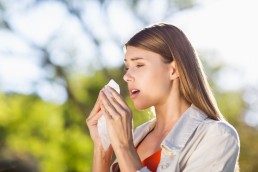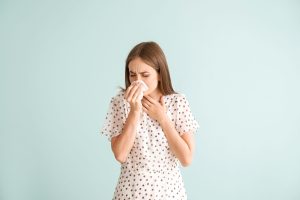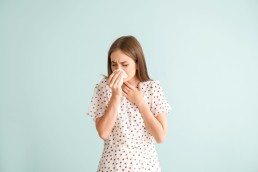A Deep Dive into Summertime Allergies
As the warmth of summer graces us with its presence, many of us are eager to embrace outdoor activities and soak up the sun. However, along with the barbecues, beach days, and sunny strolls, comes an uninvited guest: allergies. For many people, summer is synonymous with sniffling, sneezing, itchy eyes, and other symptoms that signal the onset of seasonal allergies. Let’s delve into what exactly causes summertime allergies, how they impact us, and what we can do to manage them better.
The Cause: Summer Allergens
Seasonal allergies, also known as hay fever or allergic rhinitis, are triggered by allergens—substances that the immune system mistakenly identifies as harmful. When the body encounters these allergens, it responds by producing a type of antibody called Immunoglobulin E (IgE), leading to an allergic reaction.
During the summer months, the primary culprits are pollens from grasses, weeds, and trees. While spring is most commonly associated with tree pollen allergies, summertime often sees a rise in grass pollens (such as Timothy grass, Kentucky bluegrass, and ryegrass) and weed pollens (like ragweed, sagebrush, and pigweed). Mold spores, which thrive in warm, humid environments, also become more prevalent during summer, contributing to allergic symptoms.
The Impact: Symptoms of Summertime Allergies
The allergic reaction sparked by these allergens can result in a variety of allergy symptoms, many of which can be quite discomforting. These symptoms typically include:
- Sneezing
- Runny or congested nose
- Itchy, watery, or red eyes
- Coughing
- Itchy throat or ears
- Fatigue
These symptoms can severely affect an individual’s quality of life, leading to disturbed sleep, irritability, and an inability to fully enjoy outdoor activities during the summer season.

Managing Summertime Allergies
Various strategies can help manage the symptoms of seasonal allergies and make your summer a lot more enjoyable.
1. Awareness and Avoidance
Stay updated on local pollen forecasts available online such as the United Allergy Service Pollen Forecast or through mobile apps such as myAllergyPal®, and try to limit your outdoor activities on high pollen count days. Additionally, during these peak periods, keep your windows closed and use air conditioning to keep allergens at bay.
2. Allergy Medication
Over-the-counter antihistamines can be effective for relieving allergy symptoms like sneezing, itching, runny nose, and watery eyes. Decongestants may also help to relieve a stuffy nose. For those with severe symptoms, a provider may prescribe stronger medications or recommend allergy shots (immunotherapy).
3. Good Hygiene Practices
After spending time outdoors, be sure to shower and change into fresh clothes to remove any pollen that may have settled on your skin and clothing. It’s also beneficial to wash your hands often and avoid touching your face, especially your eyes, to prevent direct introduction of allergens.
4. Home Environment Care
Use high-efficiency particulate air (HEPA) filters in your home to trap pollen and other allergens. Regular cleaning and vacuuming also help to keep your indoor environment allergen-free.
The Solution: Lasting Allergy Relief
Despite best efforts to manage allergy symptoms, over-the-counter medications and preventative measures might not be enough for some individuals. In such cases, it’s crucial to take the next step—getting tested for allergies. By identifying specific triggers, you can not only avoid those allergens but also receive targeted treatment for more effective symptom relief.
Through your provider at an allergy center near you, United Allergy Services offers comprehensive allergy testing that can pinpoint the exact allergens causing your discomfort. This personalized approach allows for a more accurate diagnosis and effective treatment plan.
For some, the path to relief could lie in immunotherapy, a treatment approach that helps the body build tolerance to allergens. United Allergy Services offers allergy shots (subcutaneous immunotherapy) and allergy drops (sublingual immunotherapy) tailored to your specific allergen sensitivities. Over time, immunotherapy can help to reduce or even eliminate your allergic responses, enabling you to fully enjoy summer.
In conclusion, while summertime allergies can put a damper on this vibrant season, there are many avenues to manage and overcome them, including avoidance, medication, and medical treatments like immunotherapy. Don’t let allergies hold you back—explore options with your provider at a local allergy center to find the best treatment path for you.
Oral Allergy Syndrome
Delicious, ripe, mouthwatering fruits and vegetables are more plentiful during these summer months. However, that that summer breeze may carry more than just excitement for the season. Some people with environmental allergies may notice that certain fruits, vegetables, or nuts give them distinct allergic symptoms, typically confined to the lips, mouth and throat. This phenomenon is known as oral allergy syndrome (OAS).
Oral Allergy Syndrome

Oral allergy syndrome, or pollen food allergy syndrome, occurs when there is a cross reaction or a confusion in the body. Some fruits, vegetables, and nuts have a similar protein to the allergy-causing protein on the surface of the pollen grain. According to the American Academy of Allergy, Asthma, and Immunology (AAAAI), "These proteins can confuse the immune system and cause an allergic reaction or make existing allergy symptoms worse, which is referred to as cross-reactivity." It is a contact allergic reaction, but it also considered a mild food allergy.
Cross Reactivity
During the summer season, cross reactivity with grass and weed pollen most commonly triggers OAS. Timothy grass, orchard grass, and ragweed pollen tend to cause more reactions. Other grasses and weeds may also contribute to OAS symptoms. People with allergy to timothy grass and orchard grass may experience OAS when consuming foods like peaches, oranges, and tomatoes. Those allergic to ragweed pollen can experience symptoms when eating foods like banana, cucumber, zucchini, and some melons such as honeydew and cantaloupe. Watermelon and white potatoes can trigger a response in both grass and weed pollen sufferers equally.
Symptoms and Treatment
Typically, oral allergy syndrome symptoms present as itching or swelling in the mouth and throat. Symptoms can also be present on the face, lips, or tongue. While the symptoms usually appear immediately after eating raw fruits or vegetables, in rare cases the reaction can occur more than an hour later. Eating the food in the rawest or purest form usually triggers the more severe symptoms. Peeling, cooking, or baking the food can greatly reduce or eliminate a reaction all together.
For most people, the allergy symptoms are localized to their mouth and are uncomfortable or annoying. However, up to 9% of people have reactions that affect a part of their body beyond their mouth. About 1.7% can suffer a life-threatening allergic reaction or anaphylaxis. For this reason, it is crucial for people to determine what might be causing their symptoms with allergy testing and food journals. Avoid eating that allergy-causing food (especially in that foods peak allergy season). It is also beneficial to consider treating the underlying pollen allergy with immunotherapy.
Amanda Hofmann, MPAS, PA-C, is a graduate of Duquesne University, in Pittsburgh, PA. After spending 8 years in clinical practice, she joined United Allergy Services where she is currently the Vice President of Clinical. Amanda is also the past president of the Association of PAs in Allergy, Asthma, and immunology.
United Allergy Services is also on Facebook, LinkedIn, or Twitter.
Summer Allergies
What do you look forward to in the summer months? I bet it isn't summer allergies! Whether you are planning to be the grill master or the ultimate host of the patio celebration, we have tips to help you prepare. Today, let’s discuss some common summer allergens you may encounter when enjoying the sun or attending summer celebrations.
During the summer months, many allergy sufferers are wary of grass pollen. They are the most common seasonal allergy triggers and are heaviest in May through August. Don't forget to check local pollen counts to determine the density of pollen in the air on any given day. Read more about Grass Pollen Allergies and avoidance tip in our blog post here.

Skin Reactions
With many summer celebrations occurring outside or around the pool, sunscreen is important to discuss. We all know sunscreen is a crucial part of summer safety, but sometimes it can cause a reaction much worse than a sunburn. Individuals can have a contact allergy to the sunscreen itself and a rash will appear where it was applied. A reaction that appears after applying the sunblock and being exposed to the sun is also possible. Apply a quick and simple patch test before applying the product to your whole body. Decide on a small area like the wrist, apply the product, and wait at least 24 hours to make sure the skin does not react.
Also, while chlorine isn't an allergen, it is an irritant and can cause problems with eye and nose itching. It can also cause breathing problems in people with asthma. If undesired symptoms are occurring while swimming, jump out of the pool. Take off your suit and wash the affected area with clean water and soap to remove traces of the remaining irritant. It is a good idea to have a rescue inhaler on hand, if prescribed to you, to calm any respiratory symptoms should they occur.
Stinging Insects
Stinging insects such as bees, wasps, hornets, and yellowjackets are most active during summer and early fall. Also fire ants are active all year round in many southern parts of the United States. People who know they are at risk for an allergic reaction to stinging insects should always carry two doses of auto injectable epinephrine. It is important to have the ability to access the injections within 60 seconds if necessary. Try to avoid the stings and bites before they occur by refraining from walking outdoors barefoot, especially in grassy areas. Skipping perfume or sweet-smelling body sprays or lotions is another good avoidance technique. Also, do not drink out of cans or bottles that have sat open and unattended. Sometimes insects can get trapped inside. Finally, when choosing the perfect outfit for the holiday weekend’s plans, leave any vivid, floral clothes in the closest.
Asthma Concerns
Fireworks, although beautiful and breathtaking, can create smoke and small particulate matter can trigger asthma. If you suffer from asthma, consider watching the fireworks from an indoor location. Similar to fireworks, smoke from grills, bonfires, firepits, or outdoor fireplaces can also trigger asthma. Try to avoid the direct smoke pathway, leave significant distance between yourself and the source of the smoke, Finally, other scented products utilized during outdoor gatherings can also contribute to air pollution and can trigger asthma. If hosting a party, contact your guests and ask if certain things like scented insect repelling candles or torch oil trigger negative responses for them.
Finally, what would a summer celebration be without all the tasty food and drinks? If food allergies are present, it may be easier to pack your own meals or snacks to have readily available. Preparing food yourself is always the safest option. If it isn't feasible to do so, you still have options. It is helpful as a host to ask about any food allergies or dietary restrictions when inviting guests to the event. It is also very helpful to label what individual dishes or offerings are and include a high-level recipe or ingredient list. That way guests can privately identify safe selections off the menu and enjoy immersing themselves in the full experience without the worry of unknown exposure.
Amanda Hofmann, MPAS, PA-C, is a graduate of Duquesne University, in Pittsburgh, PA. After spending 8 years in clinical practice, she joined United Allergy Services where she is currently the Vice President of Clinical. Amanda is also the past president of the Association of PAs in Allergy, Asthma, and Immunology.
United Allergy Services is also on Facebook, LinkedIn, or Twitter. See other interesting and related articles on the UAS Blog.
Eosinophilic Esophagitis (EoE)
Eosinophilic esophagitis (EoE) is a recognized diagnosis that produces symptoms related to dysfunction of the esophagus. In EoE, large amounts of white blood cells, specifically eosinophils, collect in the inner lining of the esophagus resulting in inflammation. Typically, the esophagus is free from eosinophils and resulting inflammation, and so in EoE, a patient will begin to notice a difference in the way they can eat and swallow food. This condition can be difficult to diagnose as other conditions can present with eosinophils in the esophagus, and historically EoE has not been a common or well-known disease. Awareness has significantly improved however in the last decade, and patients are being recognized and diagnosed much earlier. This week, the FDA has approved the first ever treatment for EoE.
Symptoms of EoE
Many EoE patients also have symptoms of one or more allergic disorders like asthma, allergic rhinitis, atopic dermatitis (eczema) and food allergy. It is important for EoE patients to be properly assessed and tested for potential allergens as well as properly diagnosed for their atopic conditions. Similar to proper diagnosis, it is crucial that any and all allergic aspects of EoE can be properly treated in conjunction with management of the EoE. Patients benefit from a team of providers working together such as a primary care provider, allergy specialist, and gastroenterology specialist.
Early diagnosis of this chronic condition is important so patients can be educated and properly managed, sparing them from discomfort, malnutrition, and even life-threatening situations. An emergent situation can arise if inflammation becomes too great and causes narrowing in the esophagus, trapping swallowed food. In younger children, EoE typically presents with poor feeding, failure to grow properly, vomiting, reflux symptoms, and abdominal pain, whereas in adolescents and adults EoE most often presents with dysphagia (trouble or painful swallowing) and emergent esophageal food impactions.
Allergy Correlation

Airborne allergies can play a role, however adverse immune responses to food are the main cause of EoE in many patients. It can be more difficult to properly diagnose food allergies in EoE patients because many do not present with the typical symptoms associated with IgE mediated food allergy. Instead of immediate itching, flushing, hives and vomiting after ingestion of the offending food, the reactions can be delayed over hours or days. Milk, egg, soy and wheat are recognized as the most common triggers for EoE, however, conventional allergy tests often fail to detect sensitivity to the foods causing EoE. This is because most food allergy reactions in EoE are delayed and caused primarily by immune mechanisms other than classical IgE-mediated food allergy.
Diagnosis
Other than proper identification and diagnosis of atopic conditions, EoE must also be properly diagnosed itself as a disease. If EoE is suspected, a specialist performs an upper endoscopy, where a small tube with embedded camera is passed down the esophagus. The tube not only has a camera and light for inspection, but a small device to take samples, or biopsies of the esophagus. The biopsies of the esophagus are examined under a microscope for eosinophils and inflammation and are necessary to diagnose EoE. A provider looks for appropriate symptoms that were described above, visual inspection of the esophagus, and examination of tissue biopsies to make the final diagnosis of EoE.
Managing EoE
There are many viable options to managing EoE effectively. Food sensitivities or allergies can be managed by removing those offending foods from a person’s diet, but only under the direct guidance and supervision of a provider. A provider can advise eliminating a specific food, or a food group based on individual history, examination, and diagnosis. This elimination approach can be helpful to some, but it is important to only remove what is advised, and a medical provider will closely monitor a person and regularly discuss nutrition and intake. Many times, a dietician is added to the medical care team to make sure a person is still receiving all the necessary nutrients. A provider’s goal is to carefully add back any foods that can in fact be tolerated and are proven not to incite eosinophils in the esophagus.
Aside from adjustments to a person’s diet, there are some medications providers use to help provide symptom relief and management of the EoE. It is important to note that aside from the first medication being approved by the U.S. Food and Drug Administration (FDA) to treat EoE, typical options for treatment include proton pump inhibitors and steroids. Proton pump inhibitors (PPIs) reduce acid production in the stomach and have also been found to be able to reduce esophageal inflammation in some patients with EoE. PPIs are very commonly used as a frontline therapeutic for EoE patients. If PPIs do not work for a patient, another option may be swallowed topical corticosteroids. Swallowing small prescribed doses of corticosteroids so they come in direct contact with and treat the inner lining of the esophagus is the most common treatment.
Amanda Hofmann, MPAS, PA-C, is a graduate of Duquesne University, in Pittsburgh, PA. After spending 8 years in clinical practice, she joined United Allergy Services where she is currently the Vice President of Clinical. Amanda is also the past president of the Association of PAs in Allergy, Asthma, and Immunology.
United Allergy Services is also on Facebook, LinkedIn, or Twitter. See other interesting and related articles on the UAS Blog.
Independence from Summer Allergies

The Fourth of July is only one week away and that likely means many are making or finalizing plans to be outside. Are you planning to be the grill master? How about the fireworks expert? Maybe you are the ultimate host of the celebration surrounded by family and friends enjoying fireworks, picnics, swimming, and outdoor activities. Here are some of the most common summer allergy tips to for attending Fourth of July celebrations. After all, it is your right to have independence from summer allergies!
Number One Summer Allergy: Grass Pollen
During the summer months, many allergy sufferers are wary of grass pollen. They are the most common seasonal allergy triggers and are heaviest in May through August. Those that suffer from grass pollen allergies can benefit from checking their local pollen counts daily. Pollen counts tend to be the highest early in the day or as the wind picks up just before a large rainstorm.
Also, try to offer guests an indoor option during your outdoor celebration if possible. Try to offer a portion of the area where guests can sit away from tall/dense grass or shrubbery. Another options would be a non-grass surface like a deck or patio. To avoid bringing those pollens inside after a great celebration, take a shower or bath before hopping into bed. This will help rinse off any sticky allergens stuck to your body or hair before they stick to your bedding.
Summer Skin Allergy: Sunscreen Reactions
Many celebrations occur outside or around the pool, so sunscreen is important to discuss. While sunscreen is a crucial part of summer safety, sometimes it can cause a reaction much worse than a sunburn. A contact allergy to the sunscreen may present as a rash appearing where it was applied. Or it could be a reaction that appears after applying the sunblock and being exposed to the sun.
To avoid a sunscreen reaction, apply a quick and simple patch test before applying the product to your whole body. Decide on a small area, like the wrist, and apply the product. Wait at least 24 hours to make sure the skin does not react.
Summer Venom Allergy: Stinging Insects
Similar to sharing the festive star-spangled celebrations with pollen and sun, consider insects as well. We know stinging insects such as bees, wasps, hornets, and yellowjackets are most active during summer and early fall. Also, fire ants are active all year round in many southern parts of the United States.
For many of us stings and bites can be uncomfortable and painful. However, there are many picnic guests that have life-threatening reactions that can result from a sting or bite. People who know they are at risk should always carry two doses of auto injectable epinephrine. They should have the ability to access it within 60 seconds if necessary. Try to avoid the stings and bites before they occur by refraining from walking outdoors barefoot, especially in grassy areas. Another helpful trick is to skip perfume or sweet-smelling body sprays or lotions. Also, drinking from cans or bottles that have sat open and unattended should be avoided because sometimes insects can be an unpleasant surprise. Finally, when choosing the perfect outfit for the holiday weekend, leave your vivid, floral clothes in the closest.
Summer Asthma Concerns
When we think of the Fourth of July, firework displays lighting up the sky quickly come to mind. Fireworks, although beautiful and breathtaking, can create smoke and small particulate matter. This can trigger asthma for some, taking their breath away in a not so enjoyable way. If you suffer from asthma, consider watching the fireworks from an indoor location. Similar to fireworks, smoke from grills, bonfires, firepits, or outdoor fireplaces can also trigger asthma for some. Try to avoid the direct smoke pathway and leave significant distance between yourself and the source of the smoke.
Other scented products utilized during outdoor gatherings can also contribute to air pollution and can also trigger asthma. If hosting a party, it would be helpful to contact your guests and ask if certain things like scented insect repelling candles, scented tiki torch oil, odor hiding fragrances or air fresheners trigger any negative responses for them.
If there is a swimming pool, remember that while chlorine isn't an allergen, it is an irritant and can cause problems with eye and nose itching. It can also cause breathing problems in people with asthma. If undesired symptoms are occurring while swimming, jump out, take off your suit and washing the affected area with clean water and soap to remove traces of the remaining irritant. You should have a rescue inhaler on hand, if prescribed to you, to calm any respiratory symptoms should they occur.
Summer Food Allergy Considerations
Finally, what would a summer celebration be without all the tasty food and drinks? If food allergies are present, it can make attending picnics and barbeques easier to pack your own meals or snacks to have readily available. Preparing food, yourself is always the safest option, however, it may not be feasible may not allow you to feel you are enjoying all the perks of a summer celebration. It is helpful as a host to ask about any food allergies or dietary restrictions when inviting guests to the event. It is also very helpful to label what individual dishes or offers are and include a high-level recipe or ingredient list. That way guests can privately identify safe selections off the menu in and will allow them to enjoy immersing themselves in the full experience without the worry of unknown exposure.
Amanda Hofmann, MPAS, PA-C, is a graduate of Duquesne University, in Pittsburgh, PA. After spending 8 years in clinical practice, she joined United Allergy Services where she is currently the Vice President of Clinical. Amanda is also the past president of the Association of PAs in Allergy, Asthma, and Immunology.
United Allergy Services is also on Facebook, LinkedIn, or Twitter. See other interesting and related articles on the UAS Blog.




